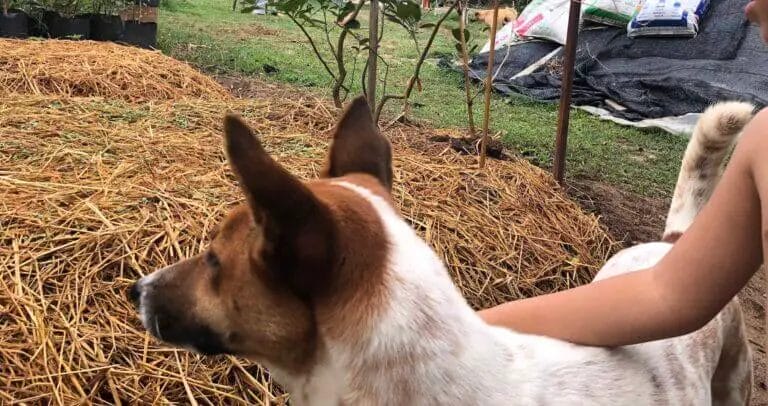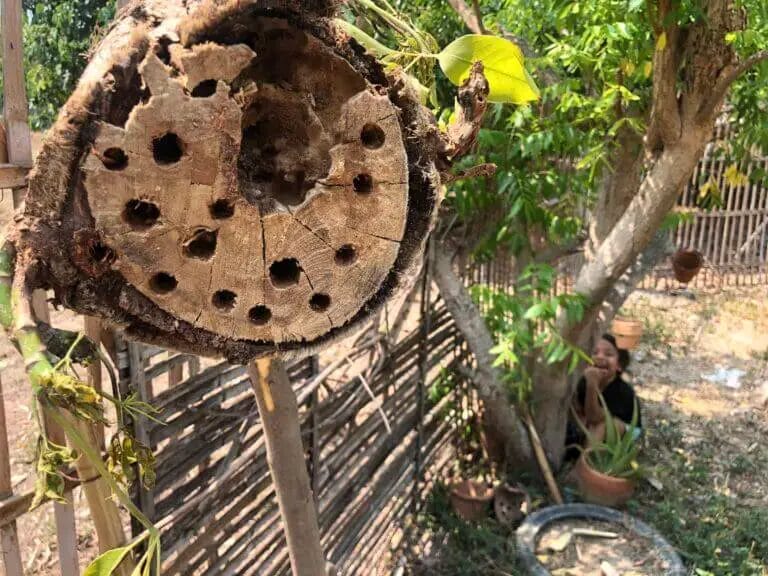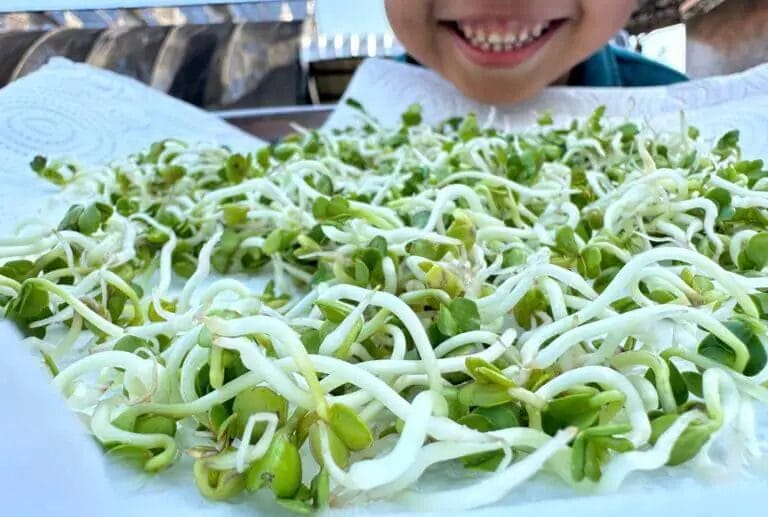Sproutingfam.com is supported by its readers. If you purchase through a link on my site, I may earn a commission. Learn more
Living Soil: Turn Any Dirt To Soil – A Natural Farming Method
Living soil comes from collecting local biomass (leaves, snail shells, plants, weeds, fruits, etc.) fermenting or composting them, and then using them as biofertilizer. This biofertilizer made from local biomass then feeds both the soil and the plants in your farm or garden.
Living soil” is any dirt or soil that has been tended to the KNF way.
Korean Natural Farming and Thai Natural Farming both use these methods to create what is now called, “living soil” which is simply the result of feeding your garden or farm’s soil biology. The local plants and materials are fermented and reintroduced to the soil and also the plants as a spray during certain stages to promote strength and help ward off insects and disease.
For the most part, the biofertilizers enrich the soil. The ferments are diluted and the composts use these organic materials as well to promote increased microbes which help make the nutrients plant-available. By feeding the plants indirectly like this, you are able to maintain good garden soil and transform any dirt to soil. “Living soil” is a way for both organic herb gardens and large scale high yield organic vegetable farms to get off chemical dependancies.
I’ve just scratched the surface on how to utilize local resources to make natural, nutrient rich living soil. As our knowledge grows, we will continue to update this blog.
Turning Dirt Into Soil
Soil microorganisms have a direct relation to soil pH. Adjusting soil pH greatly affects the nutrients plants get from the soil. With living soil, you have soil RICH in indigenous microorganisms naturally and can grow truly organic food. Natural farming uses natural inputs to create the living soil. These include things like effective microorganisms, organic liquid fertilizers, mulches made from local substances and a few other natural possibilities if needed to help enrich the soil with microorganisms and nutrients.
This also helps to prevent diseases and attacks from insects naturally. Living soil keeps the soil supplied with the goods, and not ever depleted with an erratic pH. If you farm or have any size garden, then you know the importance of maintaining indigenous microorganisms and having nutrient-rich soil.
Soil pH Is Not Tested For In Natural Farming. KNF methods do not call for any official soil pH (alkalinity vs acidity) testing, but the end result is perfect pH soil anyways.
Normally the way to go about fixing soil is to first fix soil pH by adjusting accordingly with commercially-bought products that don’t take your local environment and soil microbes into account. Experienced farmers and gardeners are good at identifying soil pH levels by touch and feel, but using a tester does help at first if you want to know soil pH numbers.
Good related read: http://extension.cropsciences.illinois.edu/handbook/pdfs/chapter08.pdf
What Is Soil pH?
Soil has a pH anywhere from an acidic 2 or 3 pH to an alkaline pH of 10. The official range is 0 to 14. pH units measure acidity or alkalinity. At pH of 7, it is neutral. From a 0 to 14 scale, pH under 7 is more acidic, and above 7 soil is more alkaline. Soil pH helps maintain the good critters like earthworms, and avoid the bad ones that like to eat through and burrow into your roots. The pH levels can make your plants sick (acidic soil, pH too low). Measuring your soil’s pH is one way to ensure you have a good quality living soil set up for plant easy growing, but not necessary or even included within traditional natural farming practices. Natural farmers are into testing by applying in small amounts and observing what happens.
Here’s how Crop Nutrition describes soil pH:
The optimal pH range for most plants is between 5.5 and 7.0; however, many plants have adapted to thrive at pH values outside this range. Because pH levels control many chemical processes that take place in the soil – specifically, plant nutrient availability – it is vital to maintain proper levels for your plants to reach their full yield potential.
The best soil pH depends on what you’re growing. Every plant has its own ideal soil pH levels. By learning how to adjust your soil pH naturally, and then learning which plants like what pH, you’ll be set to grow anything you want!
Soil Testing
Soil pH is the result of what’s in the soil. It doesn’t create soil conditions. Some commercial products like dolomite lime, for example, work good to adjust soil pH and may even be necessary depending on your time frame and needs. The following is what we currently do and know about. This soil treatment article will be updated with more info on Thai Natural Farming techniques to fix the soil as we learn them.
You can just look and feel for it, the natural farming way. Or you can use a soil pH tester to give the soil an acid test or basic pH test.
- Simple soil pH test probe: and the same pH papers used to test organic liquid fertilizers test soil pH accurately.
- Electronic Soil pH Tester: works the same way
- pH Test Strips: Just as accurate as the soil probe – just take a handful of soil, mix it in a bowl of water and test the muddy water to find the pH range. It won’t tell you the composition of the soil, but it works if you’re looking for how to check soil pH.
Raise Soil pH (for low pH soil)
You have acid soil and need to increase the pH. Raising Soil pH increases the alkalinity. Dolomite lime is the packaged commercial solution most often used to neutralize and raise soil pH. It has a mix of calcium carbonate and magnesium carbonate added to it to help plants get more nutrients from the soil. It works with the fine ground limestone to raise soil pH and make it good for growing things. It’s used until you hit your target soil pH.
Quoting the great resource that Crop Nutrition has created here, on soil acidity:
An acid is defined as a substance that tends to release hydrogen ions (H+). Conversely, a base is defined as a substance that releases hydroxyl ions (OH-). All acids contain hydrogen ions, and the strength of the acid depends upon the degrees of ionization (release of hydrogen ions) of the acid. The more hydrogen ions held by the exchange complex of a soil in relation to the basic ions (Ca, Mg, K) held, the greater the acidity of the soil.
In the case of you not needing as much magnesium that is in the packaged dolomite lime, you can use alternative means that might not be as fast acting, but might be better in the long run for your local ecosystem there where you’re gardening. When using natural farming principles based in Thai and Korean Natural Farming, commercial limestone products are not as necessary.
- Calcium Phosphorus: Water soluble calcium phosphorus can be made from things you already have in your fridge. Adding calcium via snail shells, egg shells, seashells, bones, etc. is good for the soil and plants. Plants can only use the calcium because they need phosphorus to be phosphate in order to use it. That is phosphorus in the form of an ion. This will increase the soil pH I believe.
Another good natural way to raise the soil pH is by adding liquid lactic acid bacteria (LAB) on its own. Then you can add liquid magnesium and liquid calcium made from local sources you already have. Eventually we’ll get all these liquid fertilizer recipes here up on the blog. You can use the water from washing uncooked rice, milk, brown rice and beans to make fermented liquid lactic acid that helps adjust soil pH.
There’s a great forum with many knowledgable natural farmers called Permies.com. Here’s a comment from a thread in that forum on LABs:
LABs, or its laboratory-manufactured counterpart patented EM, breaks down organic matter and assists in unlocking nutrients in the soil matrix. It is used as a foliar spray as preventative measures against airborne pathogens, ie powdery mildew. LABs can be used to get rid of any odors; wet dog, smelly animal pens, cat pee. It can be poured down the toilet for the health of a septic system. It can be sprayed in a compost pile to help speed up the breakdown process. LABs is a marvelous technology that is the gateway to the world of biofertilizers
Here’s a great video I found on YouTube showing the process step by step.. in English!
For High Soil pH (how to make soil more acidic)
Lower Soil pH (Make it more acid) if it’s too alkaline for your needs. To make soil more acidic, the most often recommended solution is to add elemental sulfur. It supports the bacteria that lower the pH in the soil. If they’re native to your area, pine cones and pine needles work great to acidify the soil and lower its pH.
Thai Natural Farming uses local indigenous microorganisms to this, so something naturally acidic or with sulfur compounds would work to lower pH. You’d collect microorganisms from your farm’s local habitat and use these strong and long lasting microbes to enrich and adjust your soil’s pH instead of commercial elemental sulfur.
Why Living Soil Is The Best Gardening Soil

To maintain a good soil pH and not be forced to choose between using chemicals or watching your plants whither away, using local microbes to make living soil does wonders.
This Thai natural farming method is being promoted by their government right now to hopefully replace conventional high chemical input farming at some point in the future. Living soil is full of indigenous microorganisms, and produces high yields from any fruits and vegetables grown in it without the use of herbicides or pesticides.
The purpose of natural farming is to grow a variety of fruits, herbs and vegetables that work together and create the perfect growing environment that regenerates soil nutrients itself and lets you grow year round in the same place without having to use chemical inputs. There is no need to squeeze the most of your farm with chemicals, only to put it on a dependency cycle that makes it harder and harder to go back to the original natural soil and environment. Not when we have solutions based on Korean Natural Farming methods.
Subsoil Needs Love Too
The subsoil is below the top 6 inches. Sometimes you can forget about this deeper soil and if it’s not good soil then you’ll have plants that don’t reach their full potential. You have to get in there before planting and tend to that dirt by turning, adding mulches and biofertilizers to increase to create a more farmable and alkaline subsoil. The dirt to soil transformation won’t be complete until you can increase your subsoil’s pH.
These are just a few options we currently use and know of. There’s much to learn and I’ll return with more direct applicable information on lowering the soil pH with KNF techniques.
Natural Farming Should Be The Future Of Agriculture (Not CRISPr!)
Thailand has it’s own Natural Farming methods based in KNF and are starting to phase it into their agricultural industry in order to calm down the use of pesticides and eventually and very hopefully one day eliminate them all together. Unnatural inputs (herbicides, pesticides, other chemicals) are not only costly, they’re unnatural and destroy the natural lifecycle of your growing environment. Natural farming makes avoiding the use of frankenfoods like GMOs and even CRISPr foods, unnecessary. Growing a thriving farm without these is very doable.
Natural Farming & Living Soil Go Hand-In-Hand
A good soil pH can come from both regular soil and living soil. But the best soil pH.. the one that is most ideal for your exact location, comes from living soil. Out in the wild the biodiversity that naturally occurs makes its soil ideal to grow from. Forest soil is some of the best thanks to all the nutrients and ranges of sunlight.
Living soil helps you grow a variety of fruits, herbs and vegetables that grow together in harmony and help each other too. This lets you grow year round in the same place without having to mess with the dirt too much. Living soil is what natural farming relies on (such as the current Thai Natural Farming I’m learning). It has a heavy Korean natural farming influence. Both farming methods are similar and rely on mulch and organic liquid fertilizers to create a biodiverse soil and then, “living soil”.
This post shared information about soil pH and how to find and attain the pH levels you need for your garden. As we learn more about living soil and how to maintain a perfect amount of natural microorganisms for that soil, we will share here.
Thanks for coming by the Sprouting Fam blog!
Next Up: These two articles will show you how to make one of the best liquid ferments in all of natural farming. And then, a soil-less way of growing indoor vegetables.
- Fermented Plant Juice (KNF fertilizer with the acronym FPJ)
- 36+ Different Types Of Sprouts You Can Grow At Home In Mason Jars







Trima kasih, perkenalkan nama saya Prabu Nawaksara. dari Indonesia, saya tertarik sekali dengan pertanian alami, dan berharap bisa banyak belajar di sini.
Good information. Thank you for making it available. I’ve made LAB, FPJ, and calcium from egg shells and bones. Keep up the good work.
Hi Greg, I never replied, but thank you for the comment and compliment. I hope all is going well with your good work on those ferments as well! We had a hiatus on everything while doing some international relocation, but we’re putting together some new garden beds now and have some ferments going now under the house in clay jars.